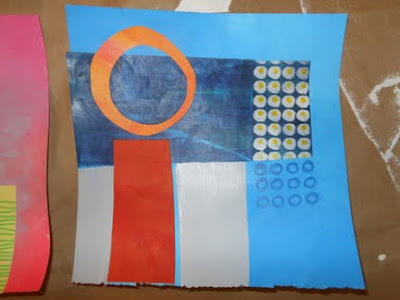A few weeks ago I posted some almost-finished work that was inspired by a suggestion on Jane Davies' blog. She proposed that we choose complementary colours to make small compositions in paint and collage, and gave some examples of her recent demo pieces on this topic.
Soon after, I attended a four-day workshop in Stowe, VT with Jane. The class was titled "Abstract Painting for Textile Artists", and Jane has posted a few photos from the workshop on her blog . The photos below are some of my "starts", not one of them finished at the time of the photo.
There were twelve of us in the class. One participant was an established watercolour painter, and most of the others were textile artists with little experience using paint.
Jane was able to cover some basics that are essential to those new to the acrylic medium: how to mix paint, how to use products like gel medium and glazing medium, how to dry brush, how to achieve smooth transitions by working wet-on-wet, painting on tissue paper, and much more. Of special interest to the textile artists was the use of a Golden product, GAC 400, which is designed to stiffen fabric so that it behaves more like paper, making it suitable for collage.
It is fascinating to watch Jane demo her own approach to making painted collage. She is absolutely fearless in her quest to "move the composition along", obliterating some beautiful passages in service to the success of the whole, seemingly ever-confident about her own ability to make good decisions in seconds.
One of our first in-class assignments was to make collage papers in a variety of techniques and a full spectral range of colour. We were then asked to assemble collages, and to add paint to them. Later, we were shown how to make interesting backgrounds and to build collages on them. So in effect we alternated from painting to collage to painting to more collage, until we were satisfied with the piece.
Throughout, Jane emphasized the value of using contrast in our compositions: contrast of value, hue, scale, texture, pattern, of hard edges and soft edges, of curving shapes and rectilinear shapes, of matte and gloss, of opaque and transparent, and so on.
Jane encouraged us to produce a number of "starts", and to rotate through them, adding or modifying each in turn. This prevents one from "getting stuck" on any one piece, and makes each little project less precious. My best guess is that none of the participants felt they had actually produced a finished piece, but that each left with a bundle of "works in progress" that they were excited to complete.
This was my second in-person workshop with Jane and, as before, what I found most valuable was her personal feedback. Just as in the previous workshop, Jane suggested that while my imagery was strong, my compositions needed more "breathing room", more quiet areas to complement the busier bits, giving the eye somewhere to rest. In fact, I did cut up some of my earlier efforts, isolating interesting parts and adding them to quieter backgrounds.
All this to say that when I returned home, I continued to work on what I had begun, and also tried to apply some of what I had learned to the blue-and-orange exercises I began last month.
And so I now have in hand ten small mixed-media works to hang at this weekend's show of the Hudson Artists. I will be sure to post some images in the next few days.
To find out more about Jane Davies, her art and the many workshops she offers, both on-line and in-classroom, please visit her website.




2 comments:
Love the colours in this work, Heather.
I would love to take one of Jane's workshops, and hopefully will in the near future. I am memezmerised by her techniques that I have seen on you tube and I enjoy how she is able to push forward on a piece without any hesitation. I can see her influence in the wonderful pieces that you posted.
Congratulations
Barbara
Post a Comment